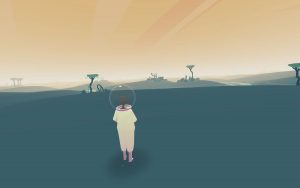
Orchids to Dusk is a short ambient game created by Pol Clarissa. In the game, you play an astronaut who has crashed landed on an alien planet. However, upon crash landing, you realized that you have a limited supply of oxygen and hence only a few minutes left to live and explore the planet.
Website Link: http://www.ko-opmode.com/orchids
Game Demo: https://www.youtube.com/watch?v=1Tw2XkQqkow
Lens of Elemental Tetrad
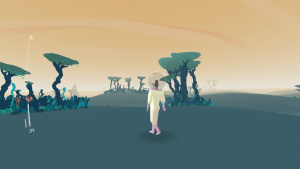
Mechanics: Orchids to Dusk is unique because even though it is such a simple game, it is also very profound. Instead of the usual action-packed adventures of normal games, Pol purposely created a game which focuses on simple idleness. Players have no objectives and are free to wander wherever they wish within the constraints of their oxygen level (which will eventually deplete) in an arid environment that was almost bare and seemed never-ending.
This setting conveys that the player is not all-powerful, and hence shifts the focus away from player-centered game-play seen in many objective-based games. Players are now forced to contemplate the character’s feelings and take in the serenity of the surroundings as they move through the landscape with the clock ticking down. This allows players to immerse and appreciate every moment of the game until the end, rather than just fixate on completing objective after objective. In this game, simple things like movement to a place would be a significant consideration, amidst the dwindling oxygen supply.
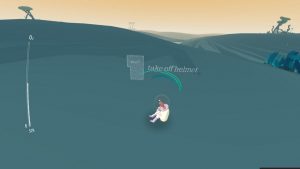
Furthermore, the game is a shared experience. Any player who plays the game would start in the same online world. In the game, you can either wait for your oxygen to deplete and pass away or you could voluntarily accept your fate and take off your helmet, following which you would become part of the landscape itself, contributing various beautiful trees and vegetation which would mark your resting place.
As a new player explores the same alien world, he can see the spots of beautiful vegetation left behind by others before him. This not only gives players certain control over death, but it also gives a sense that you are never truly alone in that world, making the concept of death seem much more accepting. The spot of vegetation left behind as you merge with the landscape after death simply adds further to the interaction between character and surroundings.
Story: There is no main plot once the game-play starts. The only background story provided in the game is the same 2-sentence introduction given at the start of this analysis. This proves that you do not always require a detailed plot to prompt players to contemplate life meanings and sincerely enjoy the interactions between character and surroundings. The lack of story seems to allow players to move away from objective-based playing to one that focuses more on the moment-to-moment interaction in the game.
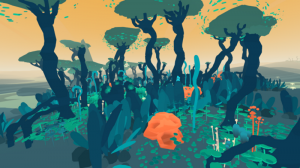
Aesthetics/ Technology: Being a game that relies heavily on the interactions between character and its landscape, the visuals of the game are simple, yet amazing. Simple in the sense as to convey the intent that the player cannot see everything in the barren alien world, yet amazing in the spots of vegetation that pop up here and there to mark the passing of other players. The graphics, such as the trees, ground vegetation and colorful swirls, were all very detailed. The character also adopts different poses with respect to his action and/or surroundings, allowing stunning shots to be taken. Each spot of vegetation was different, probably corresponding to the number of people who passed away in that spot. The use of soothing music also helped to ease the mood of the game to convey a sense of appreciation and acceptance, which is believed to match well with the intent of the game.
The game was made to be a short and simplistic game. Hence not much CPU is needed to play the game. Only around 113 MB of memory space is needed to download the game before running the application and playing it.
Overall: I believe that the intent of the game was to focus on the character’s interaction with the surroundings and to get the players to appreciate every moment in the game through contemplation of various meanings and acceptance of death itself (which, like the astronaut, is something we ultimately would face in our lives). The elemental tetrad complemented smoothly with that intent to create a shared and contemplative wandering experience.
Lens of Curiosity
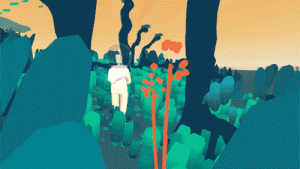
Coming into the game with no objectives and a depleting oxygen meter, it sparks a certain desire to challenge the status quo that the astronaut must die. The simple game fills into mind many possibilities, such as to explore far-away runes hoping to find habitation on the arid world, or to find a resupply of oxygen in that far-away corner, and it does this by allowing the player’s imagination to fill the almost barren landscape which sparks different possibilities and attract the curiosity of the player to explore them.
Lens of Meaningful Choices
Orchids to Dusk allows players to choose to go and explore wherever they like. It prompts the player to decide how to spend his remaining oxygen supply, whether to explore further to fulfill curiosity, to just sit down and admire the vegetation or scenery or voluntarily take off his helmet to accept death earlier. This is meaningful because it means either fighting against death till the end to explore as far as possible or to relish in the moment and accept fate. The profound concept of acceptance of death is being brought up here and left for the player to choose.
Lens of Simplicity/Complexity
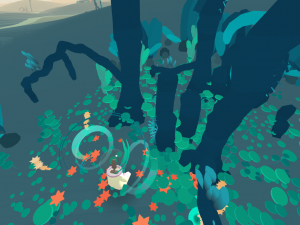
Orchids to Dusk is a very simple game with no plot or objectives during game-play, however it can bring out profound meanings and introduce the concepts of appreciation and acceptance all at once, while allowing players a certain degree of freedom to make their own choices in the arid world, e.g. whether to explore further to search for a way out or accept their fate. Its emergent complexity allows players to contemplate these concepts while playing the game.
Lens of Time
Orchids to Dusk has an optimal game-play time of around 5 minutes from the time when the astronaut crash-lands till he runs out of oxygen. The timing seems appropriate because it is not too short that players get frustrated that they die too early without being able to explore up till a certain limit of where their curiosity takes them, but also not too long such that players get bored of exploring. This is important, especially in this game where there are no plots or objectives to hold the player’s attention. Hence the whole wondering experience cannot be too long, yet must be short enough for players to immerse in the interaction with the surroundings and also contemplate on the concepts intended by Pol when he created the game, , i.e. appreciating the present moments.
